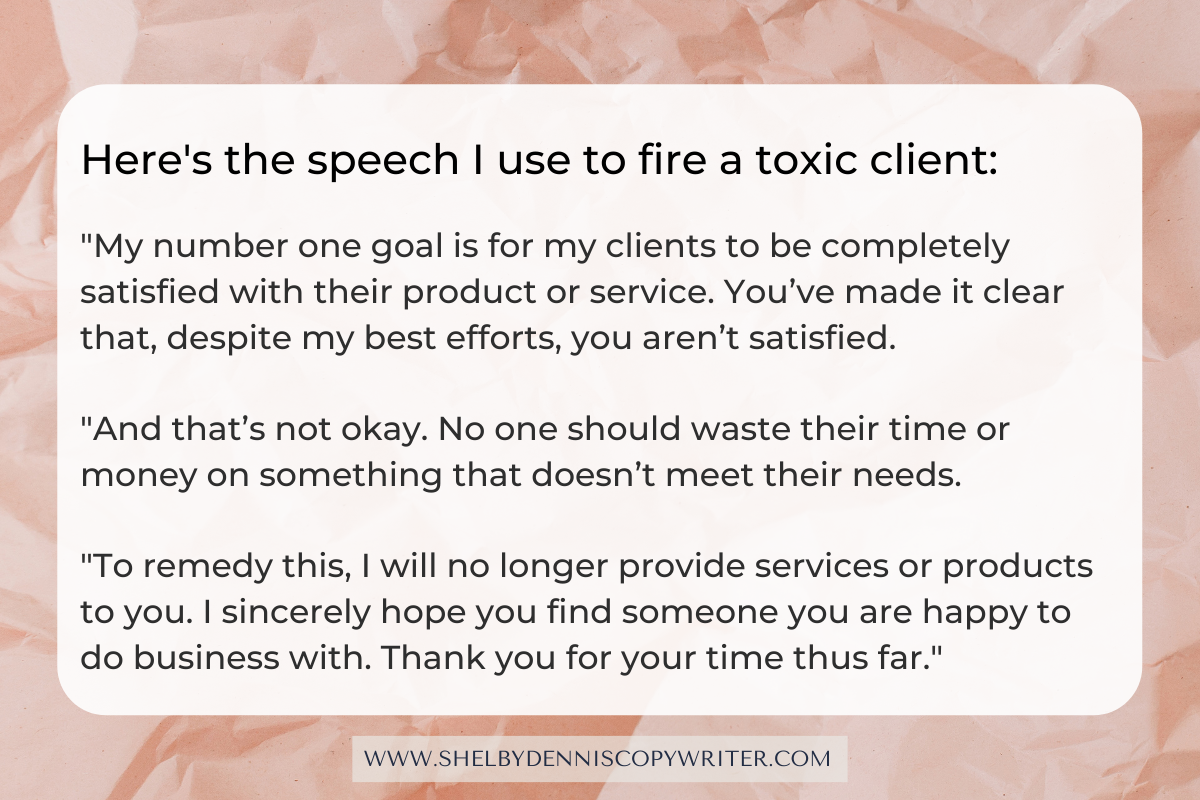- Home
- Blog
- Business Category
- Signs of a Toxic Client
6 Warning Signs of a Toxic Client… and How to Get Out Before It’s Too Late

As a freelance beauty copywriter (and beauty industry veteran), I do a lot of work with clients. While I may occasionally have a day free of phone calls or Zoom meetings, I’m generally talking with people daily. On an average Saturday at the salon, I talked to upwards of 200 people a day. (Gotta love the kids’ salon hustle!)
Basically, I’ve become intimately familiar with the warning signs of a toxic client.
I know that’s a big statement. And I know these days, “the T-word” gets thrown around without much thought. Honestly, that’s exactly why I’m writing this-- because if your role is client-facing, you are at risk of landing a toxic client.
At the same time, that risk should never hold you back from a craft you’re passionate about.
Whether you’re a hairdresser, salon owner, content writer, freelance copywriter, accountant, web designer, or a professional providing one of a million other valuable services to clients… the world needs your gift and your passion.
Letting one toxic client dull your sparkle is a disservice to you, your peers, your current clients, and even your future clients!
I don’t want that to happen. You certainly don’t want that to happen. By learning the true warning signs of a toxic client, I’m hoping you won’t ever accidentally land yourself one.
But if you do find yourself in this specific pickle, I’ve got you covered.
Today, I’m going to take you through…
- 6 warning signs of a toxic client
- 3 signs you and your client aren’t a good fit
- The difference between a toxic client and a bad fit
- How to exit a truly toxic client relationship with minimal collateral damage
6 Warning Signs of a Toxic Client
1. They violate your professional and/or personal boundaries.
Especially when you’re a newbie, it’s easy to disregard your boundaries. What’s one urgent phone call on your vacation if it helps you earn a client’s future business?
Well… the old saying “give an inch, they’ll take a mile” is an old saying for a reason.
Here’s the thing. It’s perfectly reasonable for you to tell a rational person that, just this once, you can make time for them while you’re off. If this client is indeed a rational person, it’ll end there.
If this client is not rational… well, you’ll find out pretty quick. A toxic client will turn a one-time thing into an ongoing violation of your boundaries. Here’s an example:
One of my salons had a client who refused to honor our appointment system. This client would book the last appointment before the salon closed, and show up 5 minutes past closing… by which time their appointment should’ve been completed.
The first time, the stylist and receptionist elected to stay late for this client because the client begged and pleaded.
This kept happening. Eventually, the client admitted they wanted the entire salon space to themselves. Plus, they didn’t want to be around other clients during their service. (Keep in mind this was almost a decade before COVID!)
Once the stylist realized the client had been purposefully showing up late and pressuring our staff into doing the service, I was called to the front desk.
The stylist, client, and I talked for a short while. But it was crystal clear this client was refusing to be rational or even show basic human decency. When a client refuses to honor even the most basic social etiquette (specifically, don’t call names and don’t try to grab/shove people) there’s nothing you can do.
Incidents like this are inexcusable signs of a toxic client. Fire the client. Free yourself up to work with someone who respects your boundaries.
2. They violate your professional and/or personal ethics.
What’s the difference between violating your ethics vs your boundaries? A boundary is typically something you set yourself and can adjust if you wish. For example, not answering client calls while you’re on vacation is a boundary. Your days off are your boundaries.
Ethics relate more to our intrinsic values. For example, using only vegan or sustainable materials for your products results from your ethics. Refusing to break the law for your clients is another example.
I once had a new client who swore by a drugstore brand of shampoo and conditioner. As we walked to the shampoo sink, the client insisted I use their preferred brand. They’d brought the bottles from their shower and demanded I wash their hair with that instead of the products we used.
Unfortunately, in my location, this is illegal. By law, a salon can only use products if they have the Material Safety and Data Sheets (MSDS) for that product. This paperwork includes emergency procedures if a product is ingested, gets in the eyes, all that fun stuff.
If I’d used the drugstore shampoo and gotten it in the client’s eyes… or if a client’s child found the bottles and, heaven forbid, drank the shampoo… I personally am liable for that in a court of law.
And no client is worth being liable in a lawsuit! Breaking the law for a client goes against my ethics.
This client insisted I break the law and put myself at risk so I could wash their hair. I insisted they leave without providing the service.
No amount of money from any client is worth a violation of your ethics, especially when that leaves you liable. This is one of the undeniable signs of a toxic client. My advice is to fire that client.

3. They don’t respect your finances.
As professionals, you and I understand the importance of keeping a close eye on our bottom line. It’s no surprise individuals and businesses alike are concerned about finances, too. Being engaged in the discussion of pricing and wanting to know more is not one of the signs of a toxic client.
A lack of respect for your finances, however, is a big red flag. And this can manifest in a couple of different– but equally maddening– ways. During the proposal process, a client shouldn’t be nickel-and-diming you.
Statements like “Can’t you do that for cheaper? It doesn’t seem that hard.” and “So-and-so does this for half the price. Why won’t you give me that pricing? That isn’t good business!” always spell trouble down the road.
Why? Because you haven’t even started, and they’re already dissatisfied. This almost guarantees another issue you’ll face: late payment.
You’ve outlined when payments are due, but they always come late… if at all. You’re left with no choice but to hound this person and waste time securing payment for work you’ve already done.
You may tell yourself something is better than nothing, and that’s why you tolerate this type of client. But trust me– once you remove this hassle from your life, you’ll feel so much better.
Not only will you appreciate the time you’ve gotten back, but your mental health can begin to flourish again too. They won’t be hard to replace once you’re feeling refreshed.
4. They don’t hold up their end of the deal and blame you.
This sign of a toxic client goes beyond financial drama. While payment is part of the agreement between both of you, there are usually other conditions too. It’s one thing when a client agrees to do or prepare something for you, forgets, and apologizes.
That happens to everyone. Perfection is a myth. You shift deadlines, work with what you have, and do what you can. A rational client is apologetic and supportive when they make this mistake.
The key difference here is who takes the blame… and the consequences.
In beauty school, I talked with a client who wanted bright blue streaks added to her hair. We discussed the process, how to achieve the best results, and I sent her home with a set of instructions to follow for the next few weeks.
Due to the condition of her hair, she’d need to follow these instructions to have any shot at her desired result.
At the time, she agreed. She returned a few weeks later for her appointment… and had done exactly the opposite of what she’d been instructed.
Her reasoning? She got bored with her hair during what was supposed to be a recovery period and damaged it beyond repair with dye at home.
After she explained how this was, in her opinion, all my fault… well, I was at a loss.
To this day, I’m grateful for my instructor putting his foot down and refusing the service. She’d decided her actions were my fault before we even started! I shudder to think what accusations would’ve flown if we’d tried to do anything to her hair.
This sign of a toxic client can take a while to rear its ugly head. If it does, remember that you are in control and you have the power to end the relationship.
5. They threaten you.
This is a very extreme red flag, which is exactly why we need to talk about it. I know this is just my personal anecdote, but I tolerated way too much early on in my career.
I’ve talked to plenty of other professionals with stories that, in hindsight, were clear signs of a toxic client… but at the time, we all told ourselves it was just “part of the game.”
Threats run a wide spectrum of severity. And hairdressers deal with a shocking amount of workplace violence in their careers. But we’re going to talk about threats to reputation, too.
Threats of any kind shouldn’t be taken lightly. Even if you believe that client would never act on a threat, you need to take it seriously– because the fact that they even made the threat means it could happen.
Most everyone I’ve talked with has had their reputation threatened at some point, at least once.
Whether it’s a scathing review full of lies or a blog with a false account of their experience, toxic clients love to try to leverage control of your reputation.
Very few of my colleagues have had their personal safety or property threatened (thank goodness!) but it has happened. This boils down to the same toxic desire: the client wants to control you.
In either case, my best results have come from disengaging with these clients immediately. I have a zero-tolerance policy on threats and aggression in my copywriting business.
Once a threat is made, it’ll hang over your relationship forever. It’ll poison every interaction with that client.
If they do launch a smear campaign, publish a factual account of what happened. You know who you are and what really happened. Other people will see through the lies, too.
6. Your expertise is ignored… again and again.
This warning sign of a toxic client can be easy to miss. When you look back at a relationship with this type of client, it’s easy to see your struggle. But day-to-day, this one isn’t as glaringly obvious as threats or ethics violations.
To be clear, a client wanting their bangs shorter, wanting a webpage edited, etc is no reason to burn a bridge. A healthy relationship means being comfortable discussing these things, and ultimately brings out the best in both of you.
But repeated instances of asking for your expertise, disregarding it entirely, and blaming you for their dissatisfaction is unacceptable.

3 Things That Aren’t Signs of a Toxic Client
1. You don’t provide what they need.
Picture this… A potential client contacts you, excited about your services and your pricing.
But as you learn more, you get the distinct feeling that what they need and what you do best just aren’t in alignment. It’s great to have someone excited about working with you, but you’ll both end up disappointed if you don’t offer what they need.
I once had a client who said they needed some content written. After a few conversations, I finally understood they needed a video editor, social media manager, and graphic designer.
While the services I provide have a small overlap with the services they needed, there was no way to make that cost-effective and productive for both of us.
Today, that “bad fit” and I still exchange occasional tips and referrals. Nothing toxic about an honest business relationship!
2. Their expectations aren’t realistically aligned with their scope.
Typically this is a budgeting issue. For example, a client only wants to pay for a single 500-word blog post… but they want it to function as a landing page, have SEO built-in for multiple keywords, link to 5 or 6 of their products, and also function as a case study.
Separately, those objectives are great. We could create 4 or 5 different pieces of copy to achieve those goals across 1 campaign. But when a client insists on shoehorning everything into 1 project purely to get a low price, that’s not a good fit for you.
They’d be better off with a much cheaper provider, or going back to the drawing board and clarifying their ideas before asking for proposals. Is this a sign of a toxic client? Not unless they try to threaten or pressure you into doing the work.
Otherwise, it’s just a sign of someone with lots of big ideas who needs to do a bit more strategizing and budgeting. I think we’ve all been there before, no?
3. They’re too early.
When we bought our first home, I’d just left a role at a residential remodeling company. I was very familiar with the stages and ideal order of trades to make our home remodel successful.
But I was so excited about ripping out some awful fluorescent lighting and replacing it with something new and recessed. Right after we got our keys, I called the electrician we’d be using and did a walkthrough for a quote based on our ideas at the time.
A month later, everything had changed– and I mean everything. No part of our original plans made it into the finalized plans… so I’d wasted the poor electrician’s time completely! I called and apologized profusely. I was just so excited that I jumped the gun and got info from them before we knew the answers to some crucial questions.
Luckily, we’ve since worked together quite happily! Because they understood we would need their services eventually… just not as soon as I’d thought. When a client contacts you but can’t answer the most basic questions, it’s just not a good fit… right now.
You can’t make those decisions for them. Even if you try, that client may change their mind or realize the direction they’re going isn’t the same one as you.
When a client comes to you just a bit too early, I advise explaining the basics of what they need to figure out. If they seem receptive, try booking some time for a few weeks or months out when they’ll know more.
As long as the client is understanding of what they need to do, this is definitely not a sign of a toxic client– it just means that client is excited about their project ideas!
Signs of a Toxic Client vs. Signs of a Bad Fit
I know some of these signs are similar, and the differences can be subtle at a glance. Let’s dig into these nuances so you can determine what you’re dealing with.
The way I see it, toxic clients are people I wouldn’t want in my day-to-day life. Whether it’s my grocery store cashier or my neighbor, true toxicity is impossible to be around in any capacity.
If you picture this person as your neighbor and immediately get clammy hands, a racing heart, or nausea, that’s a pretty good indicator.
In a nutshell, toxicity sets off my fight-or-flight response. I’ve heard similar from other professionals. Toxic clients have actual behavioral or personality issues that negatively impact everyone around them. They can’t be reasoned with.
But a client who’s just a bad fit? I wouldn’t stress over seeing them while I’m out for a walk. We’d make small talk at the grocery store. Both parties are at least polite, if not friendly.
You may have even referred this person to a colleague or peer. If you picture this person and recognize they’re a functioning, respectful member of society, there you go.
In short, there’s no bad blood and no reason for a fight-or-flight response. At most, you feel slightly sad you weren’t the right fit for them… but pleased that both of you could see it and move on with your lives.
Seeing Signs of a Toxic Client? Here’s How to Get Out…
I have a short and sweet speech I use every time I let a client go. I modify it as needed depending on the specific issues we’re having, but here’s the base I always use:
“My number one goal is for my clients to be completely satisfied with their product or service. You’ve made it clear that, despite my best efforts, you aren’t satisfied.
And that’s not okay. No one should waste their time or money on something that doesn’t meet their needs. To remedy this, I will no longer provide services or products to you. I sincerely hope you find someone you are happy to do business with. Thank you for your time thus far.”
You aren’t blaming them or making excuses. You’re stating basic facts. If they try to argue, you know exactly what they’ve said and done to arrive here. Feel free to give them a specific example of their obvious dissatisfaction.
When I was working in salons, this conversation typically happened at the end of an appointment… and occasionally, before we even got started!
In the marketing world, you’ll often notice red flags early on and you can fire the client quickly. If you’re in the middle of a project, though, consider your policies about refunds, deposits, and deliverables to find the right timing.
Sometimes, I say this to clients and they swear to get their act together. In my own business, I won’t walk back from this statement. Call me jaded, but the clients I’ve given second chances to have soured me on the idea. Do so in your business at your own discretion.

You’re In Control of Your Client Relationships
Seeing signs of a toxic client is never a fun experience. And in certain cases, it can be difficult to see the subtle differences between toxicity and a bad alignment.
Refer back to this guide any time a client starts to stress you out or trigger alarm bells in your head.
Truly toxic clients don’t care where you draw the line. From invoicing to the very ethics your business holds dear, these people are seeking to take control and leverage you any way they can.
Clients who aren’t a good fit are perfectly sane, respectful people. You may not communicate well or see eye-to-eye, but they aren’t rude or aggressive. Be honest anytime you encounter someone like this, and you’ll do fine.
When you need to fire a toxic client, please feel free to steal my little speech! Build onto it and personalize it however you like for each individual situation.
It’s highly likely that you’ll encounter signs of a toxic client at some point in your career.
It can be overwhelming and even scary to navigate these situations alone! Comment below or contact me if you still need some assistance letting go of a toxic client yourself.
Rooting for you,

Shelby Dennis
Your freelance beauty copywriter



Comments
Share your question or comment in the box below!